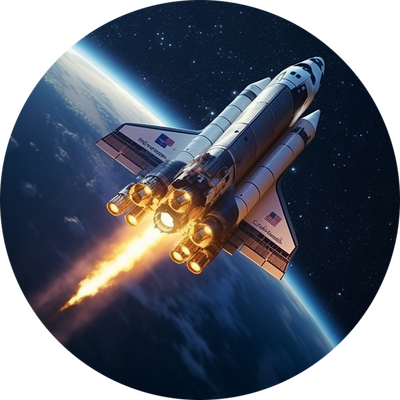Space exploration
What’s the next destination for commercial Sub-Orbital Rockets?
Commercial sub-orbital rockets are poised to redefine our capabilities beyond Earth's atmosphere.
The aerospace industry is a hotbed of innovation, with advancements occurring at an unprecedented pace. It's not an exaggeration to say that the landscape is constantly evolving, with new technologies reshaping the way we approach space exploration.
Among the standout innovations are commercial sub-orbital rockets, which are poised to redefine our capabilities beyond Earth's atmosphere.
Defining Suborbital Flight
Suborbital flight refers to a trajectory that takes a spacecraft or a rocket beyond Earth's atmosphere, but without completing a full orbit around the planet.
Unlike orbital flights that involve achieving the velocity necessary for continuous circumnavigation at about 28,000 kilometers per hour, suborbital journeys follow a ballistic trajectory, reaching the fringes of space at an altitude of 100km before returning to Earth.
From space tourism to scientific research, these rockets serve as versatile tools, unlocking the door to new possibilities in the realm of space access.
Sub-orbital Rockets
Sub-orbital spaceflight is dynamic and is marked by the deployment and development of innovative rockets that push the boundaries of exploration. Here are some notable sub-orbital rockets, both in active use and under development:
Blue Origin's New Shepard
Comprising a reusable rocket booster and crew capsule, New Shepard stands as a pioneer in sub-orbital space tourism and scientific research. New Shepard has successfully executed numerous test flights, achieving altitudes beyond the Kármán line and demonstrating reusability.
SpaceShipTwo
Virgin Galactic's SpaceShipTwo is designed exclusively for sub-orbital space tourism. Distinguished by its air-launch system, SpaceShipTwo is released from a carrier aircraft at a high altitude before igniting its rocket motor, providing a unique approach to sub-orbital spaceflight.
Rocket Lab's Suborbital Testbed Rocket
Rocket Lab, known for its orbital launches, has introduced a Suborbital Testbed Rocket designed for sub-orbital missions. Hypersonic Accelerator Suborbital Test Electron (HASTE) is designed for hypersonic test flights, emphasizing its role in advancing high-speed aeronautical research.
Current applications of Suborbital Rockets
Suborbital rockets open up a diverse range of applications that extend beyond traditional space exploration.
From space tourism to scientific research, these rockets serve as versatile tools, unlocking the door to new possibilities in the realm of space access.
Space tourism
Perhaps the most publicized application of suborbital rockets is in the realm of space tourism. Companies like Blue Origin and Virgin Galactic aim to offer civilians the extraordinary experience of reaching the edge of space, providing breathtaking views of the curvature of the Earth and a few minutes of weightlessness.
Scientific research
The unique environment provided by suborbital flights, including brief periods of microgravity, makes them ideal for conducting scientific experiments. Researchers leverage this near-weightless environment to study various phenomena, from fluid dynamics to material behavior, offering insights not achievable in terrestrial laboratories.

Atmospheric studies
Sounding rockets, a specific type of suborbital vehicle, play a crucial role in atmospheric studies. These rockets carry instruments to gather data about Earth's upper atmosphere, ionosphere, and other atmospheric conditions during their ascent and descent phases.
Technology testing
Suborbital flights serve as valuable testing grounds for new technologies and systems. Engineers can assess the performance of equipment, instruments, and components in a space-like environment, aiding in the development of future space exploration technologies.
Educational outreach
Suborbital flights provide unique opportunities for educational outreach. Engaging students in experiments or payload design for suborbital missions fosters interest in STEM (science, technology, engineering, and mathematics) fields and inspires the next generation of scientists, engineers, and space enthusiasts.
Some suborbital rockets allocate space for student experiments, allowing educational institutions to participate directly in space-related activities and gain hands-on experience in designing, building, and analyzing experiments for spaceflight.
Commercial payload deployment
Suborbital rockets, especially those designed for reusable launches, can carry and deploy small satellites into space. This capability is valuable for commercial companies seeking cost-effective options for placing small payloads into specific orbits.
Researchers leverage this near-weightless environment to study various phenomena, from fluid dynamics to material behavior, offering insights not achievable in terrestrial laboratories.
Future of commercial Sub-Orbital Rockets
As suborbital rockets progress in design, technology, and accessibility, their expanding applications bring diverse benefits across industries.
The unfolding trajectory of commercial sub-orbital spaceflight invites us to anticipate the trends and predictions that characterize this dynamic industry, considering evolving technologies, emerging markets, and the widening scope of applications.
One prominent facet of this expansion is the poised growth of space tourism, with an increasing number of individuals aspiring to partake in sub-orbital flights. The synergy of advances in technology and a competitive landscape may act as a catalyst, potentially driving down costs and broadening the accessibility of space tourism to a more extensive demographic.
Simultaneously, as the industry matures, the evolution of regulatory frameworks becomes imperative. These frameworks are expected to adapt, addressing safety, environmental, and ethical considerations. Governments and international bodies are likely to play a more active role in standardizing regulations, facilitating responsible growth in the commercial sub-orbital sector.

The trend toward reusable rocket technology, pioneered notably by companies like Blue Origin and SpaceX, is anticipated to persist. Beyond cost reduction, the emphasis on reusability contributes substantially to the sustainability of sub-orbital spaceflight, aligning with broader environmental goals.
Additionally, anticipated advancements in propulsion technologies hold the promise of more efficient and powerful sub-orbital rockets. These developments not only enhance payload capacity but also extend mission capabilities, opening new doors to diverse applications in the evolving landscape of commercial sub-orbital spaceflight.
Emerging markets for Sub-Orbital Rockets
Scientific research expansion
Sub-orbital flights will likely play an increasingly vital role in scientific research. From climate studies to material science experiments, researchers may leverage the unique conditions of sub-orbital space to gain insights into various fields.
Point-to-point Sub-Orbital Travel
Anticipate the exploration of sub-orbital travel for ultra-fast point-to-point transportation on Earth. Companies may explore the feasibility of using sub-orbital rockets to reduce travel times between distant locations drastically.
Commercial payload deployment
The demand for deploying small satellites into space is rising. Sub-orbital rockets may find a niche in the commercial space industry by offering cost-effective and rapid deployment options for small satellite constellations.
Anticipated advancements in propulsion technologies hold the promise of more efficient and powerful Sub-orbital Rockets.
Final take
The future of commercial sub-orbital rocket use holds promise for an era where the boundaries of space become more accessible and diverse applications emerge.
From an uptick in space tourism to groundbreaking scientific discoveries, the trajectory is set for continued innovation, collaboration, and exploration in the dynamic realm of sub-orbital spaceflight.
As technologies mature and markets evolve, the journey toward the edge of space is bound to become an integral part of our interconnected global future.